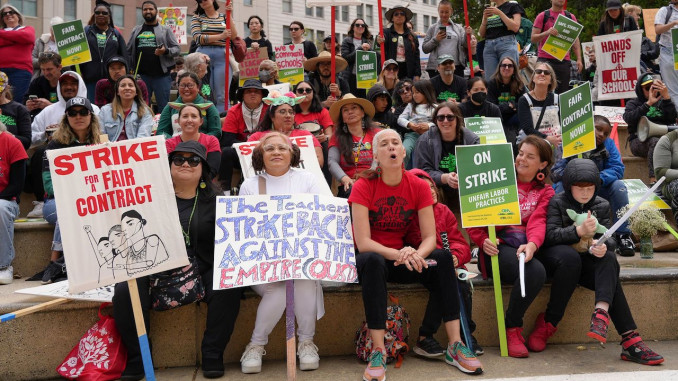
On May 4 teachers in Oakland, California, went on a seven-day strike that ended with a tentative agreement. Many teachers felt that the contract was mediocre at best. The timing of the strike was very difficult for students, teachers, staff, and families, since the end of the school year is a special time for field trips, project exhibitions, celebrations, and graduations. Teachers and staff wanted to participate in those activities with their students; families wanted their children to experience these moments. In addition, with the experiences of online learning during the COVID pandemic so fresh in everyone’s minds, additional time off of school was a burden for many students and families.
Causes of the Strike
What led to this strike and what were the results? The Oakland Unified School District (OUSD) has around 34,000 students across 78 different public schools. The teachers’ union is the Oakland Education Association (OEA) and is made up of nearly 3,000 K-12 educators. While Oakland teachers are the lowest paid in Alameda County, OUSD’s off-campus administrators receive salaries that are considerably higher than the average in other major school districts in California.
OUSD’s priorities are revealed by its spending habits. District officials claim there is a lack of funds for staff and students, yet they’re spending $57 million to build a new administrative building for themselves. In just the last three years, OUSD has added 37 new management positions that cost the district over six million dollars a year. OUSD has a history of administrative misconduct, and has been under state receivership since 2003. The low teacher pay, lack of resources, and difficult working conditions lead to high teacher turnover, with 16% of teachers leaving the district each year. In addition, OUSD is facing its fifth consecutive year of declining enrollment. California, the world’s fourth largest economy, is also responsible for the conditions in the Oakland schools, as it allocates less than $13,000 per student, while some states allocate more than $24,000.
The Oakland teachers’ contract expired in 2021, but due to the many pressing issues of the pandemic, OEA agreed to push the expiration back to the end of 2022. Contract negotiations were expected to begin at the start of the 2022-23 school year for higher salary, staff increases, and more student supports. OEA officials proposed a “big bargaining” campaign, with a goal of one representative from each of the 78 school sites across the district to engage in contract negotiations. (The team was about 50 members, with several schools unable to find someone to fill the role). They said their goal was to bring more perspectives into the negotiating room and to have transparent communication between school site bargaining representatives and union members. But beyond creating this bargaining team, very little was done to engage teachers, let alone students, families and the broader community to prepare for a contract fight.
In the spring of 2023, negotiations stalled and the district repeatedly canceled bargaining sessions, or came to the bargaining table unprepared. This allowed OEA to file an Unfair Labor Practice (ULP) lawsuit with the National Labor Relations Board (NLRB). When the NLRB rejected OUSD’s request for an injunction, this allowed OEA to call a ULP strike. Roughly three quarters of OEA members voted to authorize a strike, but they were given very little information about what this might mean or when a strike would actually happen. In fact, the messaging from some union officials was to vote yes to give the bargaining team more leverage and avoid an actual strike. When negotiations continued to stall into the first week of May, union officials called for a strike starting on May 4. It was not at all clear to many teachers, let alone to the broader school community, what the strike demands actually were and for how long and over what the strike would continue.
The entirety of the strike, from initial discussions at the union’s Representative Council in the weeks prior to final ratification of the TA, was conducted in a top-down, bureaucratic manner driven by OEA officers on full-time release (former teachers who now work full-time for OEA). There were no membership meetings held during the strike, nor online surveys to find out what members were thinking as the strike progressed. Meetings with the strike captains, as well as the Rep Council, were held via Zoom instead of in person, so that members never had the chance to connect with each other, share ideas, ask questions, or make proposals. A motion at Rep Council to hold a meeting in person during the strike was ignored by officials. The California Teachers’ Association, OEA’s parent union, swooped in during the strike and preceding weeks, performing critical functions from leading the strike captains’ meetings to checking in with members on picket lines. In a member-driven organizing structure that seeks maximum engagement, these functions would be performed by rank-and-file members and ongoing communication between school sites would be encouraged and facilitated.
During the strike, union members were told that because the strike was authorized on the basis of a ULP, the strike would end as soon as an agreement was reached and would not, as in the 2019 strike, be contingent upon the agreement’s ratification. Ultimately, the strike lasted for seven days. In the early morning hours of Monday, May 15, the district and the union came to a Tentative Agreement (TA). Union members were told to stand down from the picket lines, and were expected to return to school as usual on Tuesday, May 16. A membership meeting and vote took place after the return. The tentative agreement was ratified — 90% voted yes out of a total of 72% of the total membership. In other words, 65% of the membership voted “Yes”, 7% voted “No”. And 28% didn’t vote at all.
Results
The TA did win some modest gains. It included a 10% raise retroactive to November 2022 and a $5,000 bonus for all members, a change to the salary schedule so that mid-career teachers can reach a higher pay grade at a faster rate, a raise for substitute teachers, early childhood education teachers, and social workers, and increased stipends for bilingual educators and Visual and Performing Arts (VAPA) teachers. Ultimately, the salary increases won’t offset the inflation that people have been dealing with for the past several years. And there was very little difference in the salary gains reached in the final TA compared to the district’s last offer before the strike. In other words, after seven days of striking, the work stoppage didn’t really win much in the way of salary gains.
The TA also included some staffing increases — four additional librarians, five more counselors, and two more nurses. A number of joint district/union committees are to be set up to address complex issues such as newcomers and special education.
The other reason given by OEA officials for the need to strike was to win “common good” demands — demands that are supposed to benefit not just educators, but students and the community as a whole. These are not usually included in contract bargaining, and the School Board and OUSD officials claimed that these demands should not be part of the negotiations. Unfortunately, the contents of the Common Good demands were unclear to many teachers, students, families and the broader Oakland community, in whose interest they were supposed to be negotiated. Many members on the picket line were confused about the specifics of the demands, and asked for more information because they didn’t even know what to write on their picket signs! Since there was not a concerted effort by the union to actively organize and mobilize teachers, students, families and community members around these demands, there was no real expanded organizing and mobilization to back up what was going on at the bargaining table.
OEA initially submitted an expansive, detailed proposal with bold Common Good demands to OUSD. These demands included that OUSD fund bus transportation for students, work with a local housing agency to establish housing for unhoused students at shuttered school sites, restore case managers for unhoused and foster students, provide more bilingual mental health providers, and allocate $10 million in a Black Thriving Schools fund to increase the number of therapists, arts educators, reading specialists, and restorative justice coordinators at historically Black schools. OEA also called for OUSD to cut central office management and staff to state averages prior to any school closure recommendations.
In reality, very few of the common good demands resulted in substantial gains. They were settled not through the TA, but through a side bargaining process called a Memorandum of Understanding, or MOU. Union members can’t even vote on the MOU, which was simply approved by union officials. The Common Good MOU sets up a steering committee of parents, students, educators and classified staff to determine how the $66 million set aside for California community school funding will be allocated. It also authorizes the creation of a task force of students, parents, teachers, and OUSD staff to act as a decision-making body for the the creation and implementation of the Thriving Black Student Plan. There will also be five additional teachers on special assignment at historically Black schools. For student housing and transportation support, the MOU was limited to setting up procedures and committees to discuss the problems, but nothing really binding to solve them.
In other words, with the exception of the five new teaching positions at historically Black schools, the supposed wins for the community resulted in little more than the creation of committees and task forces. This is a far cry from OEA’s initial demands, which were much more expansive, detailed, and impactful. Of course, the goals of the common good demands are worthy ones, and most in Oakland would agree with them. But realizing these demands requires deeper systemic change, changes that are difficult to win through a union contract fight, especially one made by only one local union without any meaningful engagement of members, families and students in shaping and fighting for the demands.
A Different Way Forward
It can feel really disappointing to educators that their seven-day strike yielded such minimal and inadequate gains. Working families who sacrificed seven days of pay so they could keep their students at home could also be rightfully disillusioned. In the end, the contract negotiations and the resulting strike were limited by the top-down approach of the OEA leadership. And while the big bargaining committee was a good idea, it didn’t really connect the bargaining team to the rest of the membership to allow for two-way communication and decision-making. There were no membership meetings held during the strike, and not even any online surveys were done to find out what members were thinking as the strike progressed. Meetings with the strike captains, as well as the union’s Representative Council, were held via Zoom instead of in person, so that members never had the chance to connect with each other, share ideas, ask questions, or make proposals. The lack of organizing, first by the teachers themselves, and then a failure to engage the larger community in a meaningful way, really limited what could be won. This is where we must be the most clear: it was dishonest to lead educators and families into a taxing strike and claim that the strike would yield transformative wins for reparations, housing and transportation. These kinds of gains require a mobilized membership and community that is linked to a broader social movement that goes far beyond the boundaries of one small union.
Another Way Forward
However, another perspective was certainly possible. Following the 2019 OEA strike, there were discussions among some local teachers’ unions, including Oakland, San Francisco, Los Angeles, and San Diego, about linking up their struggles to wage a united fight for better education in California. Instead of each local union bargaining and striking on its own, which has an extremely limited impact, a state-wide approach would have brought a lot more organized forces together and created the basis for a much more powerful fight. Such a fight could also easily be supported by other workers beyond those in education. In expensive cities like Oakland and Los Angeles, a living wage that keeps pace with inflation is a demand that could resonate with many workers. The fight for lower class sizes could be linked to nurses fighting for lower patient caseloads, or with warehouse drivers fighting for less crushing and fast-paced delivery expectations. The possibilities are endless — but only if approached with the perspective of waging a broader, more united struggle across the working class, instead of an isolated fight in one small union in one city in California. This could certainly become a future goal for Oakland teachers and others.




